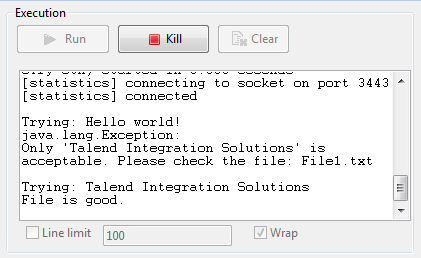|
Component Family |
Exception |
|
|
Function |
cTry offers the Java equivalent |
|
|
Purpose |
cTry is designed to build |
|
|
Usage |
cTry is used as a middle component |
|
| Connections | Try |
Select this link to isolate the part of your Route that is likely to throw an exception or exceptions. NoteWhen the Try link is followed by multiple components, a compile error may occur showing “ |
| Catch |
Select this link to catch any exception thrown in the In the Exceptions field, type in NoteThis link can be used only when a Try link is present. |
|
| Finally |
Select link to execute final instructions regardless of any NoteThis link can be used only when a Try link is present. |
|
| Route | Select this link to route all the messages from the sender to the next endpoint. |
|
|
Limitation |
n/a |
|
In this scenario, the content of each file sent from the message sender to the receiver is
checked and if any file does not meet the content requirement, an exception is thrown
and the relevant information is displayed on the console.

-
From the Messaging folder of the
Palette, drop twocFile components onto the design workspace, one as the
message sender and the other as the message receiver. -
From the Exception folder, drop a
cTry component onto the design
workspace to build Try, Catch and Finally blocks. -
From the Processor folder, drop two
cProcessor components onto the design
workspace. -
Link the cFile component serving as
message sender to the cTry component using
a Row > Route connection. -
Link the cTry component to one cProcessor using a Row > Try connection. This
cProcessor component will throw an
exception if any file coming via this connection does not contain the
required content. -
Link the cTry component to the other
cProcessor component using a Row > Catch
connection to catch the exception. This cProcessor component will display the information related to
the exception and the file name that does not contain the required
content. -
Link the cTry component to the receiving
cFile component using a Row > Finally
connection. -
Label the components according to their roles in the Route.
-
Double-click the cFile component labeled
Sender to open its Basic settings view in the Component tab.
-
In the Path field, fill in or browse to
the path to the folder that holds the source files. -
From the Encoding list, select the
encoding type of your source files. Leave the other parameters as they
are. -
Repeat these step to define the output file path and encoding type in the
Basic settings view of the other
cFile component, which is labeled
Receiver. -
Double-click the cProcessor component labeled Throw_exception to open its Basic settings view in the Component tab, and customize the code in the Code area to throw an exception and display
relevant information if any file coming via the try connection does not meet the content requirement, as
follows:123456789String body = exchange.getIn().getBody(String.class);System.out.println("Trying: "+body);Exception e = new Exception("Only 'Talend Integration Solutions' is acceptable. Please check the file:");if(!"Talend Integration Solutions".equals(body)){throw e;}else{System.out.println("File is good.");} -
Click the catch connection and then the Component tab to open its Basic settings view, and fill the Expression field with an expression to specify the type of
exception to catch.In this scenario, fill in
Exception.classto catch any exception
thrown.
-
Double-click cProcessor component labeled Show_exception to open its Basic settings view in the Component tab, and customize the code in the Code area to display the exception information
and the related file name, as follows:12System.out.println(exchange.getProperty("CamelExceptionCaught")+" " + exchange.getIn().getHeader("CamelFileName")); -
Click Ctrl+S to save your Route.
-
Click the Code tab at the bottom of the
design workspace to check the generated code.
As shown above, while messages are routed
fromthe sender
.tothe receiver,.doTry(),
.doCatch()and.doFinally()blocks are built
bycTry_1. Thus, when any file does not meet the content
requirement, an exception is thrown and caught, before each file is finally
routed to the receiver. -
Press F6 to execute the Route.

RESULT: When a file that does not meet the content requirement is detected, an exception
is thrown, and the exception information is displayed on the console.
Regardless of the exception, all the files from the sender are sent to the
receiver.